If you are wondering, are guppies tropical fish then you’re in the right place.
I’m going to answer this question in this article.
Guppies are small freshwater tropical fish. They are one of the most popular freshwater aquarium fish. They are found in all the continents except Antarctica. The ideal temperature for guppies is between 72° to 78°F.
Now that you know guppies are tropical fish, let’s now see why they are considered tropical fish.
And how you can create an ideal tropical environment in your tank to keep guppies.
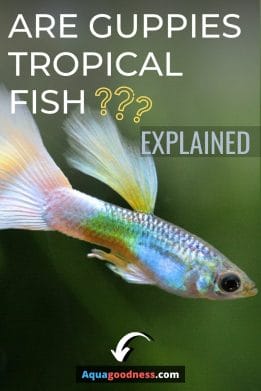
Table of Contents
Why are guppies considered tropical fish?
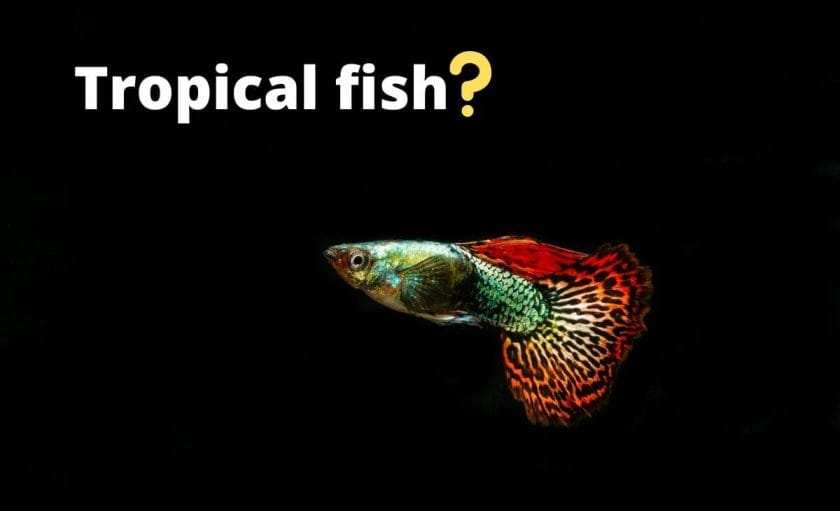
Guppies are originally from Antigua and Barbuda, Barbados, Suriname, Guyana, Trinidad and Tobago, and Venezuela.
These areas have a tropical climate. A tropical climate basically means that the temperature in this area throughout the year is more than 18 ℃ (64.4 ℉) or higher.
That’s why guppies are considered tropical fish.
Guppies are very adaptable that’s why now guppies can be found in most of the world except Antarctica.
They are so adaptive that they are not only found in freshwater but also found in brackish water. And you may even keep them in a saltwater tank.
In fact, many saltwater tank owners use guppies to cycle their fish tanks!
Guppies are very easy to care for. They are so hardy that if you live in the tropics then you can even keep them in your outside ponds and they’ll do just fine.
How to create a tropical environment in your tank for guppies?
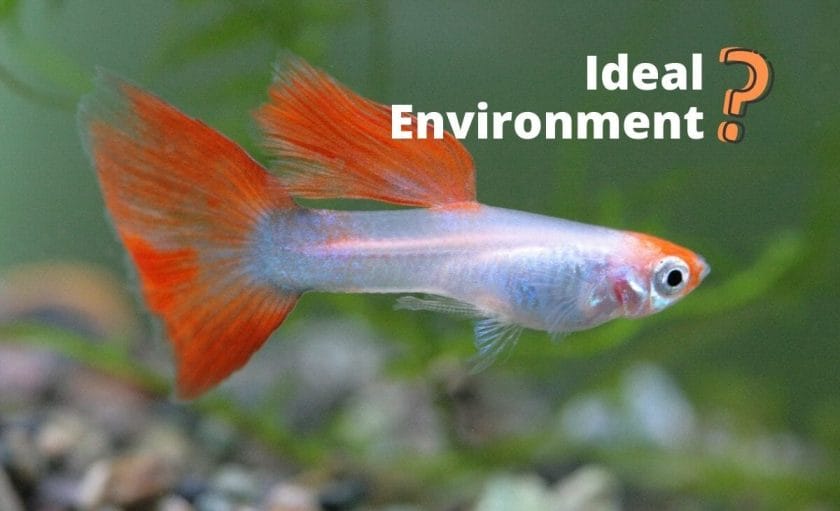
To keep healthy and happy guppies in your tank you’ll need to create an ideal environment for them in your tank.
As guppies naturally live in a tropical climate, you’ll need to emulate the tropical climate in your tank to create an ideal environment for guppies in your tank.
How to set up a guppy fish tank?
Setting up a guppy fish tank is similar to setting up a fish tank for any freshwater fish. But you’ll need to keep in mind a few details (which I’ll show you in this article) while setting up a guppy tank.
First of all, you’ll need to choose the right size for the guppies.
So what is the best tank size for guppies?
Generally, you should choose the tank size according to the size of the fish and the number of fish you want to keep in your tank.
Guppies can grow about 2 inches long. So you can fit in a trio of guppies (1 male and 2 females) in a 5-gallon tank.
However, guppies are voracious breeders. After setting up the tank, very soon you’ll notice guppy fry popping in your tank. And then a 5-gallon tank will not be sufficient.
So ideally, you should get at least a 10-gallon tank for a trio of guppies.
If you want to keep more than three guppies then you should get a bigger tank.
Once you’ve decided on the tank size then comes the time to cycle the tank.
There are different ways to cycle a fish tank.
You can cycle your tank without fish or you can go for fish-in cycling.
I’ve written a detailed article on how to cycle a fish tank without fish. You can check it out here.
You can also use live aquarium plants to cycle your fish tank.
You can cycle your tank using fish food!
In this article, I’ve explained the process of cycling a tank with fish food.
Generally, it can take anywhere between 4 to 6 weeks to cycle a tank.
But there are a few ways to cycle a fish tank instantly. Here’s are the fastest ways of cycling a fish tank.
Setting up equipment
Once your fish tank is cycled. Now it’s time to add the essential equipment to the tank.
You may have already set up a filter and even a heater in your tank during the cycling process. (Usually higher temperature helps to cycle a fish tank fast so setting up a heater while cycling a tank is beneficial).
Now it’s time to add other equipment like an aquarium light, air pump, and most importantly for guppies, a heater if you have not already added a heater.
Aquarium light
Setting up an aquarium light is important because it enhances the color of your guppies.
There are a lot of aquarium lights available in the market. You can go as fancy as you want with the aquarium light with the features you may never use.
If you are just staring out then I recommend Finnex Stingray 2 Aquarium LED Light
It is from a reputed brand and it gets the job done.
You can check out its latest price and review at Amazon here.
It is also a very good beginner light if you’re planning to keep some live plants in your guppy tank which I highly recommend because there are a lot of benefits of keeping live aquarium plants in a tank.
Air pump
An air pump is not an absolute necessity in a tank if your tank is already well-oxygenated.
However, I like to have an air pump in my tank just to make sure my tank is always well oxygenated.
An air pump basically creates water agitation on the surface of the water of your aquarium which helps to oxygenate the tank.
There are a lot of air pumps in the market to choose from. The problem with most of them is they are noisy.
I recommend Tetra Whisper air pump.
This air pump comes from a reputed brand and it is very quiet.
You can check out its latest price and review at Amazon here.
Set temperature between 72° to 78°F (22° C to 25° C)
The most important part of creating a tropical environment in your fish tank for guppies is setting up temperatures between 72° to 78°F (22° C to 25° C).
Guppies can tolerate a decent range of temperatures.
So you can keep guppies at lower than 72° F but then the guppies will grow very slowly.
And if the temperature is very low then they may never reach adulthood.
Also, at lower temperatures, guppies will breed less often.
On the other hand, if you maintain a temperature in your tank of more than 78° F then guppies will grow faster. And they will not live long.
So the sweet spot is somewhere between 72° to 78°F (22° C to 25° C).
You can easily raise the temperature of the water in your tank to the ideal range using a heater.
I recommend Cobalt Aquatics Flat Neo-Therm Heater.
It is a very reliable heater and it comes with an adjustable thermostat.
You can check out its latest price and review at Amazon here.
Maintain ideal pH for guppies (7.0 to 7.2)
Guppies can tolerate a wide range of water parameters. This is the reason they are spread around the world.
Guppies can tolerate water pH of anywhere between 5.5 to 8.5.
However, the ideal pH range for guppies is between 7.0 to 7.2.
You can easily check the pH of the water in your aquarium using an aquarium water test kit.
I recommend API FRESHWATER MASTER TEST KIT.
It is a liquid-based test kit so it is pretty accurate.
You can check out its latest price and review at Amazon here.
How to increase pH in your aquarium water?
If you found that the pH in your aquarium water is lower than 7 then you can add one tablespoon of baking soda per 5 gallons in your tank to increase the pH of your aquarium water.
The best practice is to remove the guppies from the tank before adding the baking soda.
Once you’ve added the baking soda and checked your aquarium water with the test kit then you can re-introduce guppies in the tank.
Other methods to increase the pH of aquarium water includes
1. Adding crushed corals or dolomite gravel
Put crushed coral or dolomite gravel in a mesh bag and put it in your aquarium filter to increase the pH of your aquarium water.
2. Add limestone or coral rock
You can decorate your aquarium with limestone or coral rock to increase the pH of your aquarium water.
How to lower the pH of your aquarium water?
If you found the pH of your aquarium water more than 7.3 then you can add peat moss or decorate your aquarium with natural driftwood to lower the pH.
Remember, if you have a large aquarium then you’ll need to add a lot of natural driftwood in your tank to lower the pH.
If you have a small tank (less than 10 gallons) then 1 to 2 pieces of natural driftwood will be sufficient to lower the pH.
Both peat moss and natural driftwood contain tannin that lowers the pH of aquarium water.
If you want to read more about the ideal water parameters for guppies then I’ve actually published an in-depth guide on the same topic on this site. You can check it out here.
What other tropical fish can you keep in your guppy tank?
There are several varieties of tropical fish you can keep with your guppies.
1. Neon Tetras
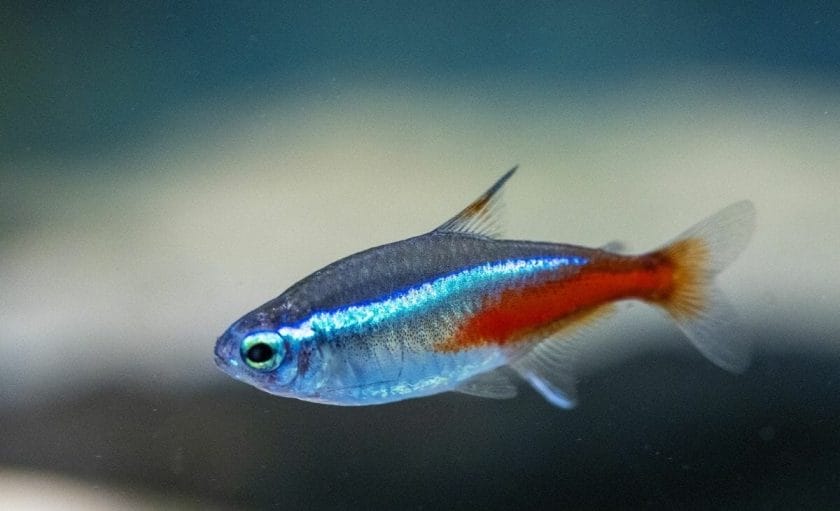
| PARAMETERS | VALUES |
|---|---|
| FISH | Neon tetra |
| SCIENTIFIC NAME | Paracheirodon innesi |
| CARE LEVEL | Intermediate |
| MAXIMUM SIZE | 1.5 inches |
| AVERAGE LIFESPAN | 5 years |
| DIET | Omnivore |
| WATER TEMPERATURE | 68 to 79 F |
| WATER pH | 7 |
| WATER HARDNESS | Up to 10 dGH |
| MINIMUM TANK CAPACITY | 10 gallon |
| BREEDING | Egg scatterer |
You can keep neon tetras as well as other varieties of Tetra fish like lemon tetra, rummy nose tetra, penguin tetra in your guppy tank.
Tetras are schooling fish so you should keep them in a group.
Tetra fish are smaller in size so they will not eat guppies. However, they do eat guppy fry.
So they are a good option if you don’t want to breed guppies.
If you want to breed guppies then you can create a lot of hiding places in your tank for guppy fry.
An easy way to create a lot of hiding places in your guppy tank is by adding some live aquarium plants.
Here are the best live aquarium plants you can add to your tank to create hiding places for guppy fry.
Just like guppies, neon tetras are omnivorous so you can feed them both plant-based and meaty diets.
Talking about water conditions, neon tetra needs similar water temperature and pH as guppies.
2. Bristlenose Pleco
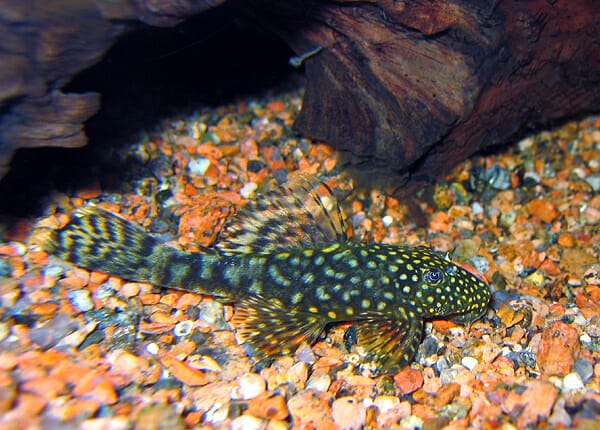
Image by Pia Helminen under CC BY-SA 3.0
| PARAMETERS | VALUES |
|---|---|
| FISH | Bristlenose Pleco |
| SCIENTIFIC NAME | Ancistrus Cirrhosus |
| CARE LEVEL | Easy |
| MAXIMUM SIZE | 5 inches |
| AVERAGE LIFESPAN | 5+ years |
| DIET | Herbivore |
| WATER TEMPERATURE | 73° - 81° F |
| WATER pH | 5.8 to 7.8 |
| WATER HARDNESS | 2° to 30° dH |
| BREEDING | Egg layer |
Bristalnose plecos can tolerate a wide range of water parameters.
Though Brsistalenose plecos are larger in size, they will not eat your guppies because they are herbivorous.
Besides, they are bottom dwellers so they spend their time at the bottom of the tank foraging for food. So they will not bother your guppies.
Talking about food, as Bristalnose plecos are herbivorous so you should mostly feed them algae wafers.
They will also eat algae in your tank which will help to keep your tank clean!
You can also treat them with vegetables like zucchini, spinach, romaine, etc.
Guppies can also eat these vegetables!
I’ve written a detailed article about all the human food guppies can eat. You can check it out here.
As Bristlemnose pleco grows larger in size (up to 5 inches) so they need a larger tank.
So you should keep it in your tank if it is at least a 20 gallon.
3. Harlequin Rasbora
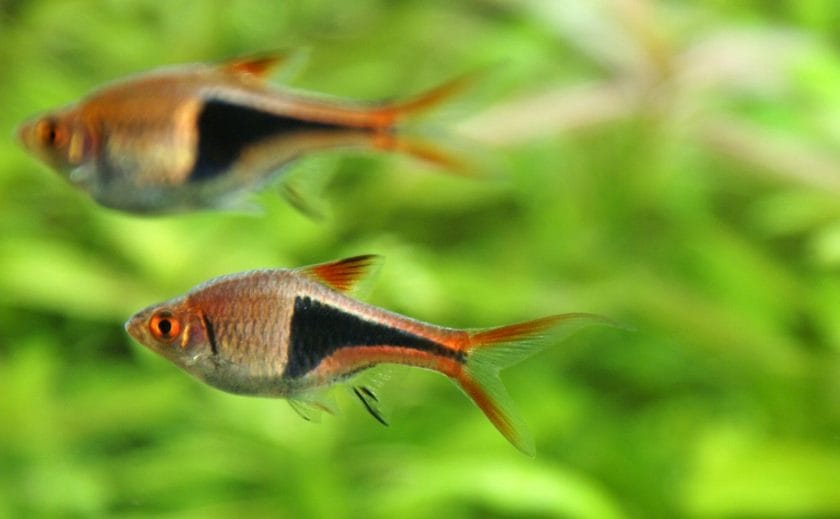
Image by Stefan Maurer under CC BY-SA 2.0
| PARAMETERS | VALUES |
|---|---|
| FISH | Harlequin Rasbora |
| SCIENTIFIC NAME | Trigonostigma heteromorpha |
| CARE LEVEL | Easy |
| MAXIMUM SIZE | 2 inches |
| AVERAGE LIFESPAN | 3 - 5 years |
| DIET | Omnivore |
| WATER TEMPERATURE | 72°F - 80° F |
| WATER pH | 5.5 - 7.0 |
| WATER HARDNESS | Up to 12° dH |
| BREEDING | Egg layer |
Harlequin rasboras have a peaceful temperament and they grow similar to the size of guppies. So Harlequin rasbora and guppies can happily live together in the same tank.
Harlequin Rasbora are schooling fish so you should keep them in a group in your tank.
The natural habitat of Harlequin Rasbora contains a lot of vegetation. So if you want to keep them with your guppies then you should consider planting some live aquarium plants in your tank.
I’ve written a detailed article containing the best live aquarium plants for guppies.
As far as water parameters go, Harlequin Rasbora needs similar water parameters that guppies need.
Harlequin Rasboras are omnivorous so they will eat both plant-based and animal-based foods.
In their natural habitat, they mostly consume insects. So whenever possible you should feed them live foods like bloodworms, daphnia, etc.
You can also feed them frozen foods.
So these were a few beginner-friendly fish you can keep with your guppies. There are some other beginner fish you can keep with your guppies.
Other beginner-friendly fish you can keep with guppies.
1. Molly Fish
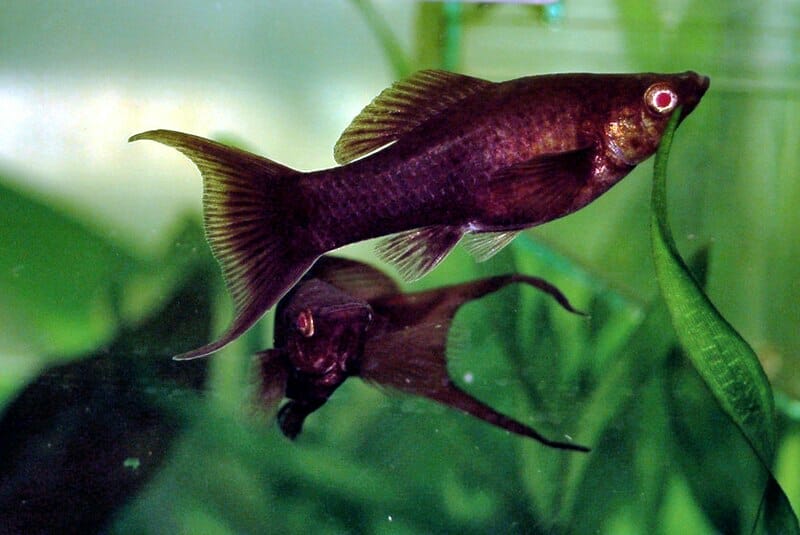
Black Molly by Marrabbio under CC BY-SA 3.0
| PARAMETERS | VALUES |
|---|---|
| FISH | Black Molly |
| SCIENTIFIC NAME | Poecilia sphenops |
| CARE LEVEL | Easy |
| MAXIMUM SIZE | 4 inches |
| AVERAGE LIFESPAN | 3 - 5 years |
| DIET | Omnivore |
| WATER TEMPERATURE | 70°F - 82°F |
| WATER pH | 7.5 - 8.5 |
| WATER HARDNESS | 10° to 25° dH |
| BREEDING | Live-bearers |
2. Swordtail Fish
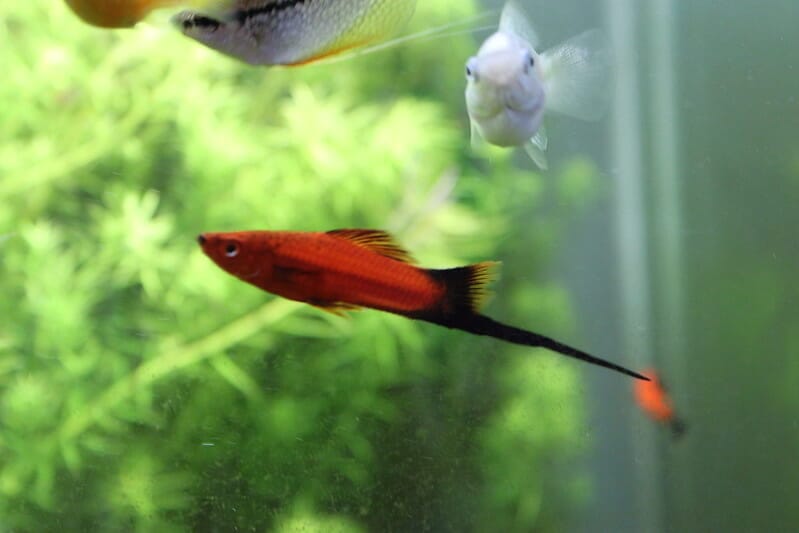
Image by Bernat Arlandis under CC BY-SA 2.0
| PARAMETERS | VALUES |
|---|---|
| FISH | Swordtail |
| SCIENTIFIC NAME | Xiphophorus helleri |
| CARE LEVEL | Easy |
| MAXIMUM SIZE | 5 inches |
| AVERAGE LIFESPAN | 3 - 5 years |
| DIET | Omnivores |
| WATER TEMPERATURE | 72°F - 82° F |
| WATER pH | 7 - 8 |
| WATER HARDNESS | 9° to 15° dH |
| MINIMUM TANK CAPACITY | 10 gallon |
| BREEDING | Livebearer |
3. Cory Catfish
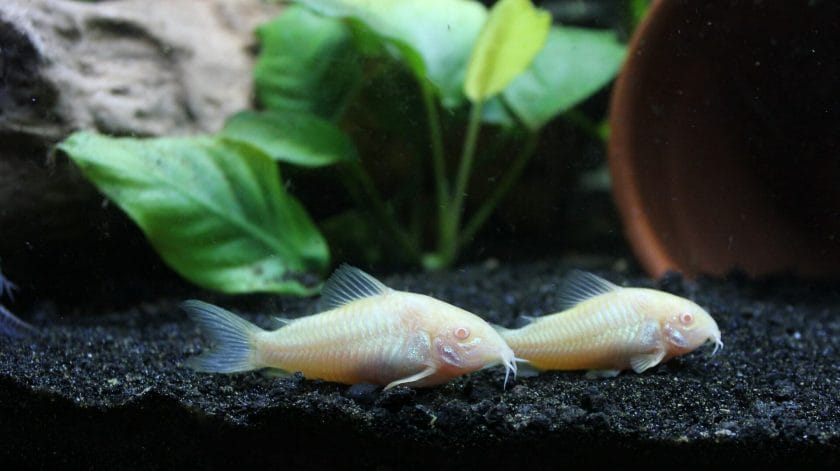
| PARAMETERS | VALUES |
|---|---|
| FISH | Corydoras |
| CARE LEVEL | Easy |
| MAXIMUM SIZE | 0.75-4 Inches |
| AVERAGE LIFESPAN | 5 Years |
| DIET | Omnivorous |
| WATER TEMPERATURE | 72 – 78°F |
| WATER pH | 7.0 – 7.8 |
| WATER HARDNESS | 5-10 dH |
| BREEDING | Egg layers |
4. Danios
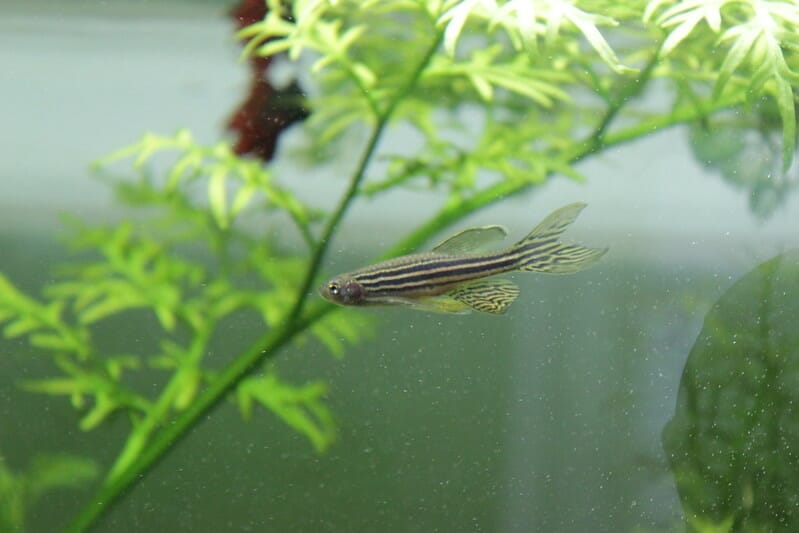
Image by Bernat Arlandis under CC BY-SA 2.0
| PARAMETERS | VALUES |
|---|---|
| FISH | Zebra Danios |
| SCIENTIFIC NAME | Danio rerio |
| CARE LEVEL | Easy |
| MAXIMUM SIZE | 2 inches |
| AVERAGE LIFESPAN | 5 years |
| DIET | Omnivore |
| WATER TEMPERATURE | 64° - 74° F |
| WATER pH | 6.5 to 7.0 |
| WATER HARDNESS | 5° to 12° dH |
| MINIMUM TANK CAPACITY | 10 gallon |
| BREEDING | Egg layer |
Here are some other tropical fish that might be difficult to keep with guppies if you are a beginner.
1. Angelfish
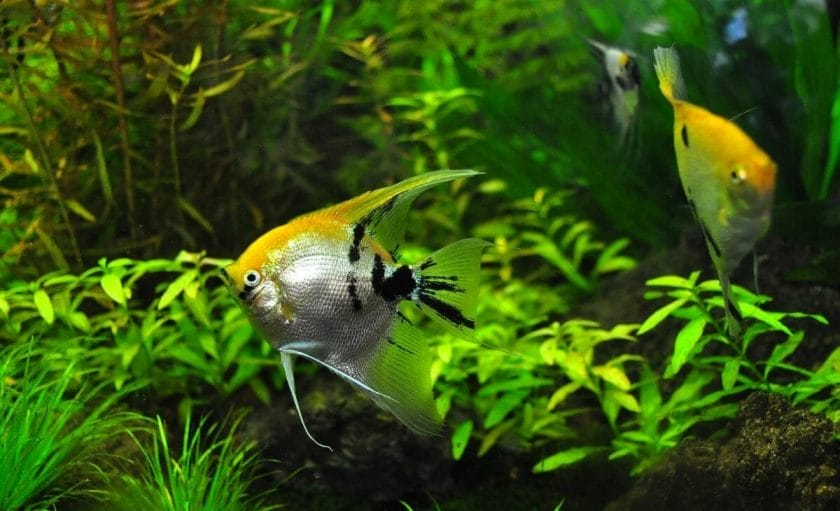
| PARAMETERS | VALUES |
|---|---|
| FISH | Angelfish |
| SCIENTIFIC NAME | Pterophyllum scalare |
| CARE LEVEL | Easy |
| MAXIMUM SIZE | Up to 6 inches |
| AVERAGE LIFESPAN | 8 - 10 years |
| DIET | Omnivore |
| WATER TEMPERATURE | 78 to 84 °F |
| WATER pH | 6 - 7.5 |
| WATER HARDNESS | 5° to 13° dH |
| MINIMUM TANK CAPACITY | 20 gallon minimum |
| BREEDING | Egg layer |
2. Betta Fish

| PARAMETERS | VALUES |
|---|---|
| FISH | Betta Fish |
| SCIENTIFIC NAME | Betta splendens |
| CARE LEVEL | Easy |
| MAXIMUM SIZE | 2.25-3 inches |
| AVERAGE LIFESPAN | 3-5 years |
| DIET | Omnivores |
| WATER TEMPERATURE | 77° and 86° F |
| WATER pH | 6 - 7.5 |
| WATER HARDNESS | 5° to 20° dH |
| MINIMUM TANK CAPACITY | 2 gallons |
| BREEDING | Egg layer |
3. Gourami Fish

| PARAMETERS | VALUES |
|---|---|
| FISH | Pearl Gourami |
| SCIENTIFIC NAME | Trichopodus leerii |
| CARE LEVEL | Medium |
| MAXIMUM SIZE | 4-5 inches |
| AVERAGE LIFESPAN | Up to 5 Years |
| DIET | Omnivorous |
| WATER TEMPERATURE | 77°F - 82°F |
| WATER pH | 6 - 8 |
| WATER HARDNESS | 5° to 15° dH |
| MINIMUM TANK CAPACITY | 30 Gallons |
| BREEDING | Bubble nest builder |
4. Discus Fish
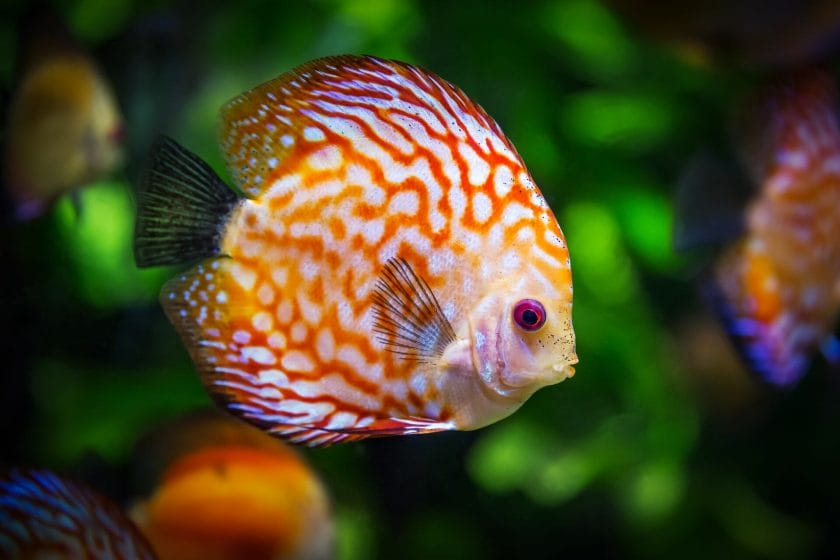
| PARAMETERS | VALUES |
|---|---|
| FISH | Discus |
| SCIENTIFIC NAME | Symphysodon aequifasciatus |
| CARE LEVEL | Moderate to Difficult |
| MAXIMUM SIZE | Up to 6 inches |
| AVERAGE LIFESPAN | 10 years or more |
| DIET | Omnivore |
| WATER TEMPERATURE | 80°F - 86°F |
| WATER pH | 6.4-7.8 |
| WATER HARDNESS | 1° to 8° dH |
| MINIMUM TANK CAPACITY | 55 gallon |
| BREEDING | Egg layer |
5. Ram Cichlids
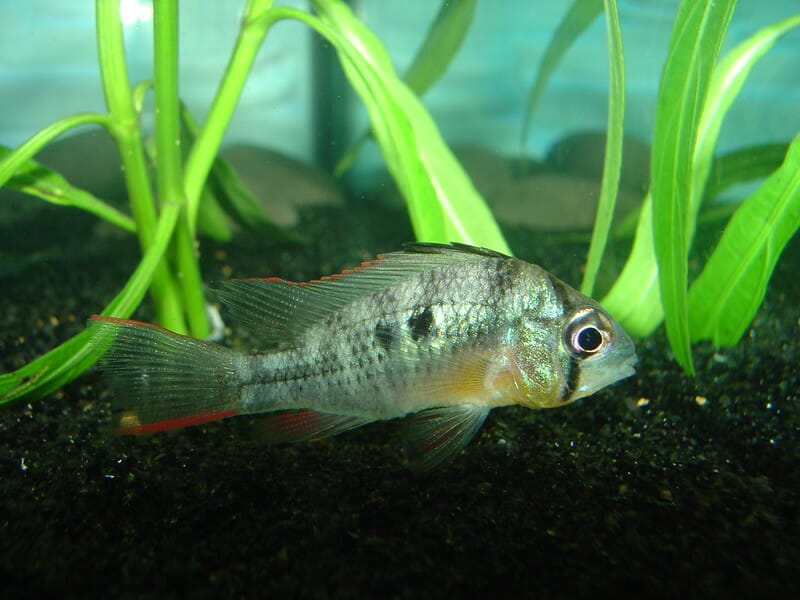
Image by NonstickRon under CC BY-SA 2.0
6. Otocinclus Fish
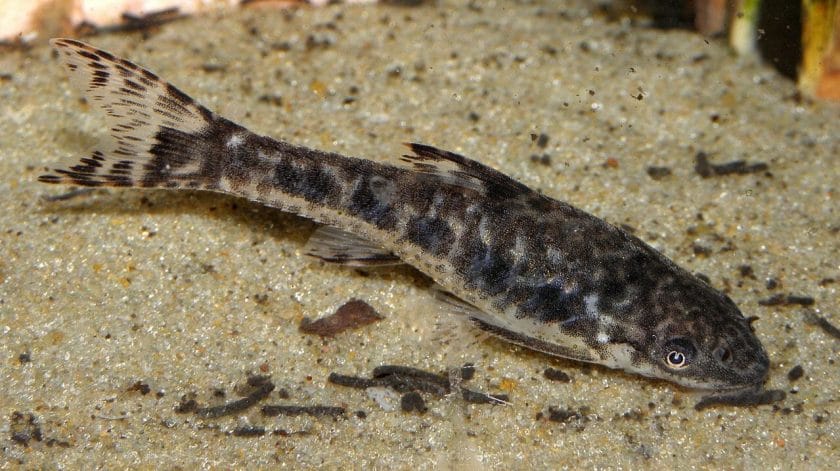
Image source under CC BY-SA 3.0
| PARAMETERS | VALUES |
|---|---|
| FISH | Otocinclus |
| SCIENTIFIC NAME | Otocinclus sp. |
| CARE LEVEL | Easy |
| MAXIMUM SIZE | 1-2 inches |
| AVERAGE LIFESPAN | 3-5 years |
| DIET | Herbivore |
| WATER TEMPERATURE | 74-80 Degree F. |
| WATER pH | 6-7.5 |
| WATER HARDNESS | 6° to 15° dH |
| BREEDING | Egg layers |
7. Shrimp

| PARAMETERS | VALUES |
|---|---|
| FISH | Cherry shrimp |
| SCIENTIFIC NAME | Palaemonetes sp. |
| CARE LEVEL | Easy |
| MAXIMUM SIZE | 1 - 2 inches |
| AVERAGE LIFESPAN | 1 - 2 years |
| DIET | Omnivorous |
| WATER TEMPERATURE | 65°F - 80°F |
| WATER pH | 6.5 - 8 |
| WATER HARDNESS | NA |
| BREEDING | Egg layers |
Conclusion
Guppies are found in tropical areas where the temperature is more than 18 ℃ (64.4 ℉) or higher.
That’s why guppies are considered tropical fish.
Guppies are very adaptive fish. And this is the reason they are found almost all over the world.
If you want to keep guppies in your tank then you should emulate the tropical environment in your tank.
The tips mentioned in this article will help you create the ideal environment for guppies in your tank.
I hope you found this article helpful.
If you do, then please share it.
Happy fishkeeping!